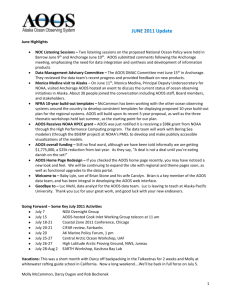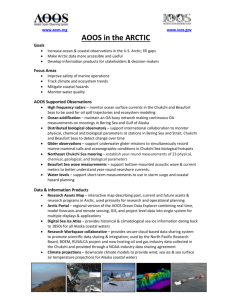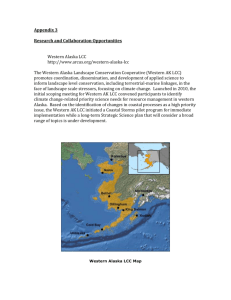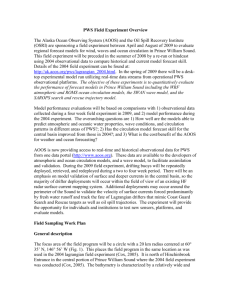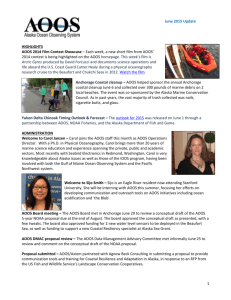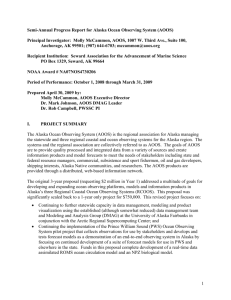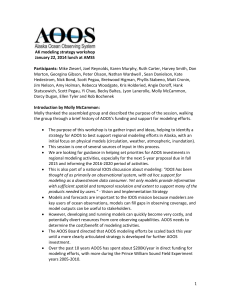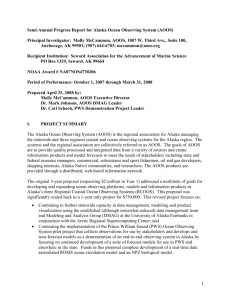NOAA Award No.: NA08NOS4730406
advertisement
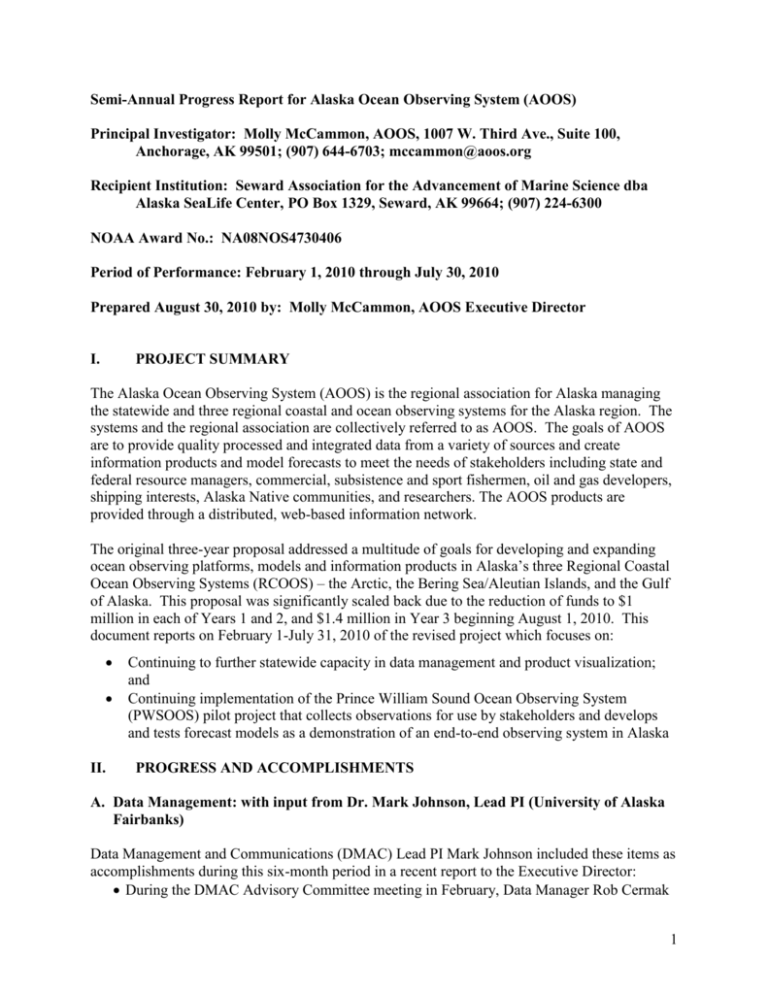
Semi-Annual Progress Report for Alaska Ocean Observing System (AOOS) Principal Investigator: Molly McCammon, AOOS, 1007 W. Third Ave., Suite 100, Anchorage, AK 99501; (907) 644-6703; mccammon@aoos.org Recipient Institution: Seward Association for the Advancement of Marine Science dba Alaska SeaLife Center, PO Box 1329, Seward, AK 99664; (907) 224-6300 NOAA Award No.: NA08NOS4730406 Period of Performance: February 1, 2010 through July 30, 2010 Prepared August 30, 2010 by: Molly McCammon, AOOS Executive Director I. PROJECT SUMMARY The Alaska Ocean Observing System (AOOS) is the regional association for Alaska managing the statewide and three regional coastal and ocean observing systems for the Alaska region. The systems and the regional association are collectively referred to as AOOS. The goals of AOOS are to provide quality processed and integrated data from a variety of sources and create information products and model forecasts to meet the needs of stakeholders including state and federal resource managers, commercial, subsistence and sport fishermen, oil and gas developers, shipping interests, Alaska Native communities, and researchers. The AOOS products are provided through a distributed, web-based information network. The original three-year proposal addressed a multitude of goals for developing and expanding ocean observing platforms, models and information products in Alaska’s three Regional Coastal Ocean Observing Systems (RCOOS) – the Arctic, the Bering Sea/Aleutian Islands, and the Gulf of Alaska. This proposal was significantly scaled back due to the reduction of funds to $1 million in each of Years 1 and 2, and $1.4 million in Year 3 beginning August 1, 2010. This document reports on February 1-July 31, 2010 of the revised project which focuses on: II. Continuing to further statewide capacity in data management and product visualization; and Continuing implementation of the Prince William Sound Ocean Observing System (PWSOOS) pilot project that collects observations for use by stakeholders and develops and tests forecast models as a demonstration of an end-to-end observing system in Alaska PROGRESS AND ACCOMPLISHMENTS A. Data Management: with input from Dr. Mark Johnson, Lead PI (University of Alaska Fairbanks) Data Management and Communications (DMAC) Lead PI Mark Johnson included these items as accomplishments during this six-month period in a recent report to the Executive Director: During the DMAC Advisory Committee meeting in February, Data Manager Rob Cermak 1 responded in detail to questions on the data system functionality, structure, and products. Following the DMAC Committee review and in response to the committee’s recommendations, the Data Management (DM) staff spent the next several weeks improving further the navigation and web page design while consolidating existing access to the real-time data. At the request of the Executive Director, following the Board’s decision to hold the open competition for data management services, Johnson and staff provided some documentation for the upcoming request for proposal (RFP) on hardware, software, products developed, Integrated Ocean Observation System (IOOS) guidelines and protocols for DMAC, and updated the DMAC work plan. After the RFP was posted indicating that software, hardware and code would be delivered to the new awardee, the AOOS DM team further documented the system under development and merged functionality from multiple servers to the single AOOS server. (Note: Additional information was requested by potential bidders during a pre-bid conference in late May, and the Executive Director requested Steve Lewis, a National Oceanic and Atmospheric Administration (NOAA) Fisheries IT expert and member of the AOOS data management advisory committee, to meet with the University of Alaska Fairbanks (UAF) team to develop the additional information.) Efforts during this reporting period focused on creating a package for transition. In addition to preparing material for the next awardee as requested, DM staff responded by phone and email to queries about the RFP. To ready the AOOS server for transition, the group began decommissioning the DM web site in early July. In addition, Data Manager Rob Cermak participated in the IOOS Regional DMAC workshop in March 2010 and the Products Workshop in Ann Arbor Michigan in May 2010. The UAF team proposed to the executive director in June a $305,000 year-long transition plan that would have begun in August. However, not knowing if UAF was submitting a proposal in the competition, and not knowing the scope of the proposals that were eventually submitted, one of which included UAF as a partner, it was impossible to consider any potential transition until the review process had occurred. The review took longer than anticipated since it included inperson interviews with the two finalists. Thus, with a termination of funding, all UAF data management staff committed to other projects as of August 1, 2010. A server and final materials have been shipped to the AOOS offices in Anchorage, but an accounting of what has been provided has not yet occurred. Data Management RFP Executive Director McCammon had originally planned to conduct a formal external review of the AOOS data management system. However, since a number of issues had arisen during final contract arrangements for Year 2 of the grant with UAF, and since a request for an updated Data Management Status Report and Work Plan for the upcoming year was not answered, McCammon arranged with the new Data Management Advisory Committee chair Dr. Phil Mundy to conduct a review during December 2009 and January 2010. Mundy was asked to review the status of the entire system, the roles and responsibilities of the staff, and the processes for internal decision-making and reporting. Unfortunately, a death in Dr. Mundy’s family prevented his accomplishing this review. 2 Instead, the AOOS Data Management Advisory Committee met February 1, 2010 and again on February 8, 2010 to hear updates on AOOS and IOOS activities, AOOS DMAC activities, and in particular, the status of the system, and to review the draft DMAC plan and proposed activities, the AOOS website, and the process for identifying priority products. Following its meeting, the committee made several recommendations about the current AOOS data system, website, and processes which are in the process of being acted on. However, the advisory committee was not the appropriate forum for addressing other fundamental issues with management of the data contract and the structure of the team’s accountability and reporting to the executive director. The executive director met with the IOOS office in February 2010 and with the AOOS Board in March 2010 to pursue the option of restructuring the data management grant by holding an open competition and establishing a new contract with more specific requirements for reporting and accountability. After discussions with the IOOS office, it was decided to pursue this during 2010, rather than waiting for the next grant proposal with NOAA IOOS which would not begin until summer 2011. The AOOS Board approved holding an open competition for Data Management Services at its Board meeting on March 15, 2010. A Notice of Intent to Release an RFP for AOOS Data Management Services was posted on the AOOS website and circulated widely among the data management and ocean observing communities on April 7, 2010 in order to provide advance notice of this opportunity. The final RFP was developed with input from a wide variety of data providers, federal and agency staff, and stakeholders. It was reviewed and approved by the AOOS Board May 11, 2010 and later that day the RFP documents were posted on the AOOS website and circulated broadly among the data provider and ocean observing communities. A bidders conference was held in Anchorage on May 27, 2010 with approximately 20 people attending in person and by teleconference. Responses to additional questions and requests for information received at that conference and in subsequent emails were posted on the website and circulated to all potential bidders to ensure that all bidders were provided the same information. A total of eight (8) proposals were received by the June 25, 2010 deadline: six (6) for the full range of data management and product development services, one (1) for data management services only and one (1) for product development only. Proposals were screened to ensure that they met proposal requirements, and they all did. An independent review panel met in Anchorage AK on July 7 and 8, 2010 for Phase I of the review process: to review the eight (8) proposals received in response to the RFP. On Day 1 the panel discussed in depth all eight (8) proposals and then ranked them in order. The two (2) proposals submitted for only partial services were not ranked, but were reviewed and discussed as possible options for consideration. On Day 2 of the review, the panel focused its attention on the two (2) highest ranked proposals and prepared more detailed questions for the proposers in order to elicit more information for use in developing a final recommendation. For Phase II of the review process, the two (2) finalists were invited to in-person presentations to the review panel on August 2 and 3, 2010 in Anchorage. They were asked to respond to several questions in writing in advance, to demonstrate during their presentation three data products that they had developed, and to be prepared to answer other questions in person. The panel discussed the presentations and the additional information received and developed its recommendation to 3 me on the afternoon of August 3. The AOOS Board met on August 6, 2010 and approved contracting with Axiom Consulting and Design for AOOS data management services. B. Prince William Sound Demonstration Project: Dr. Robert Campbell, Lead PI, Prince William Sound Science Center Funds in this proposal had previously been used to complete the four (4) major AOOS models and conduct the observing system experiment (OSE) July 19 to August 3, 2009. Model assessment and development of publications and presentations of the results of the OSE are ongoing. Several presentations were given at the American Society of Limnology and Oceanography (ASLO) and American Geophysical Union (AGU) Ocean Sciences meeting in Portland Oregon in February 2010, and several manuscripts are in preparation for a special issue of Continental Shelf Research. A summary publication on the OSE authored by Carl Schoch and Yi Chao was published in the May 18 2010 issue of Eos. An independent panel met June 28, 2010 to review the Prince William Sound (PWS) system following the five-year ramp-up and summer 2009 field experiment, and make recommendations on future activities. That review is assessing the observation platforms, models, and data products in terms of their costs and benefits to stakeholders. The team’s report will help the AOOS Board determine future directions and funding. Key components of the PWS ocean observing system now include both fixed platforms and periodic surveys. The observational program was used to provide real-time data directly to various user groups and to develop numerical models for forecasting weather, waves, and ocean conditions. These models include the Weather Research and Forecasting (WRF) model, the Simulating Waves Nearshore (SWAN) model, and the Regional Ocean Modeling System (ROMS). The ROMS model developed for PWS is capable of data assimilation allowing the use of real-time observations to correct for model error. Regional Oceanographic Modeling System (ROMS) modeling (Dr. Yi Chao, Jet Propulsion Laboratory) The ROMS modeling group continues to support the PWS 2009 Sound Prediction community by providing the ROMS output at the Jet Propulsion Laboratory (JPL) web site. A reanalysis of the results of the 2009 OSE is currently underway, and the results will be included in several manuscripts that will be submitted to the Continental Shelf Research special issue. Ecosystem modeling (Dr. Fei Chai, University of Maine) As a part of PWS operational modeling activity, nutrient phytoplankton zooplankton (NPZ) processes have been incorporated into the ROMS circulation model. Dr. Chai at the University of Maine has been collaborating with Dr. Yi Chao and his group at University of California Los Angeles (UCLA) and JPL, and we have successfully implemented a NPZ model into the threelevel nested ROMS, with 1 km resolution (level 2) for the Prince William Sound region. The NPZ model is based on the Carbon, Silicate, and Nitrogen Ecosystem (CoSiNE) model, which was developed for the equatorial Pacific and modified for the Gulf of Alaska and PWS. 4 We are continuing our model evaluation with available observations, and continuing to improve overall model performance in resolving the seasonal cycle of chlorophyll, primary production, nutrient transport and light fields. We are also incorporating micronutrient iron into CoSiNE. There are still some issues with the code and treatment of iron in the model, but they are being addressed. Some of the preliminary results will be presented at the December 2010 AGU meeting in San Francisco. Observing System Experiment (Mark Halverson, Prince William Sound Science Center) Most of the work during this period was focused on preparing a manuscript for the observing system special issue slated for publication in Continental Shelf Research. This manuscript intends to characterize the circulation in PWS with observations made during the experiment. Special emphasis will be put on the surface circulation as it is the most comprehensively measured portion of the water column and because of its importance in spill response and Search and Rescue (SAR) operations. The relative role of geostrophy and wind-driven forcing will be quantified, and a summary of the observations made in PWS to date will be made to provide some context for the relatively short period covered by the experiment. The subsurface moorings at Hinchinbrook and Montague Entrances were recovered from their final deployment. This deployment spans November 2009 until April 2010. No instruments were lost during this time, making it the first successful winter deployment. Data processing on all the deployments is currently underway. When the processing is finished, the data will be sent to AOOS for archival and to Yi Chao at JPL for model verification. Nearshore moorings (Dr. Robert Campbell, PI) Three nearshore moorings deployed April 7, 2009 on (Ship Escort Vessel Response System (SERVS), a division of the Alyeska Pipeline Service Company) floats located in Port San Juan, Naked Island, and Esther Island were removed on March 30, 2010. Each mooring consisted of a Seabird Electronics Model 16 (measuring conductivity, temperature, and pressure), and a WETlabs FLNTUSB (chlorophyll fluorescence, turbidity). Measurements had been taken every ten minutes. On March 24, 2010, a representative from SERVS officially requested that the moorings be removed from all SERVS floats, citing excessive corrosion observed during their spring dive surveys of the mooring tackle. After removal, the moorings were cleaned and readied for redeployment, and we are currently searching for a new partner to deploy them. The most likely partner at this time is the Prince William Sound Aquaculture Corporation, which operates several hatcheries in the PWS region 5 III. SCOPE OF WORK (PLANS FOR NEXT YEAR) A. Data management 1. Develop web-based map of Arctic assets to be deployed in Chukchi and Beaufort Seas in summer 2011. 2. Develop a contract with the new data team, Axiom Consulting and Design and a first year work plan. 3. Develop transition data portal by October 1, 2010. 4. Develop performance metrics, prioritize legacy datasets and system functionality for new system, design post project transition plan and develop system security strategy. 5. Redesign AOOS website. 6. Develop beta version of new data portal and acquire user feedback during Alaska Marine Science Symposium and Alaska Forum on the Environment. 7. Release first production level data portal in summer 2011. 8. Initiate interoperability project with Alaska Department of Fish and Game. B. Prince William Sound Observing System 1. Complete the independent review. 2. Complete analysis of field experiment results, continue assessment and refinement of models (ROMS, WRF, SWAN and NPZ) and develop publications and presentations. 3. Support maintenance of Snotel weather stations. 4. Redeploy nearshore moorings when a new partner is identified. 5. ROMS: use the results from the OSE to continue refining the ROMS and, in particular, improve the estimates of freshwater input. 6. WRF: The funds requested will be used to 1) maintain the model forecasts for PWS and work with the National Weather Service (NWS) Forecast Office to make them operational; 2) develop automated validation of the model; 3) input additional local data into the forecast; 4) validate the precipitation outputs from WFR for Prince William Sound using five years of data from the SnoTel meteorological stations and 5) start running a cluster of ensemble of WRF runs in order to improve the base model. 7. SWAN: Use satellite and in situ wave observations for validating model results and satellite wind and wave observations for data assimilation to enhance model results. 8. NPZ: Use ground-truth biological samples collected during the OSE to evaluate the success of the model and modify the initial conditions in additional simulations. C. Expand PWS components to Cook Inlet 1. Expand WRF atmospheric model to provide for Cook Inlet wind information and support SWAN model development by NWS. 2. Purchase and deploy a Coastal Data Information Program (CDIP) buoy in collaboration with Army Corps of Engineers and National Weather Service. 3. Coordinate Cook Inlet Working Group activities. D. Gulf of Alaska climate and ocean acidification monitoring 1. Support Seward Line cruises in 2010 and 2011. 2. Collect and analyze water samples for measuring ocean acidification. 6 E. Harbor Observing Network 1. Provide funding for installation and operation of two new stations in network, contingent on harbors providing funds for equipment. F. Arctic Observation System 1. Purchase glider to support program monitoring climate trends in Arctic. 2. Purchase ocean acidification sensors for existing moorings in Chukchi Sea. 3. Support development of electronic sea ice atlas and climatology. IV. LEADERSHIP & PERSONNEL The most significant change has been with the AOOS data management team. An entire new team is in place as of August 16, 2010 with a new Principal Investigator, Rob Bochenek of Axiom Consulting and Design. V. BUDGET ANALYSIS All financial reports are up to date and have been submitted on time. Spending is on track for the Prince William Sound components. The final invoices from UAF for the data management team are still being reviewed. A final accounting of equipment and transition products has not occurred. 7

